Shefa-'Amr
Shefa-ʻAmr, also Shfar'am (Arabic: شفاعمرو, Šafāʻamr, Hebrew: שְׁפַרְעָם, Šəfarʻam) is an Arab city in the Northern District of Israel. In 2019 it had a population of 42,137,[1] with a Sunni Muslim majority alongside large Christian Arab and Druze minorities.[2]
Shefa-ʻAmr
| |
|---|---|
| Hebrew transcription(s) | |
| • ISO 259 | Šparˁam |
| • Also spelled | Shfar'am (official) |
View of Shefa-'Amr | |
 | |
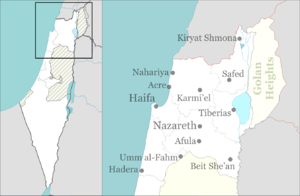 Shefa-ʻAmr  Shefa-ʻAmr | |
| Coordinates: 32°48′20″N 35°10′10″E | |
| Grid position | 166/245 PAL |
| Country | |
| District | Northern |
| Founded | Bronze age |
| Government | |
| • Type | City |
| • Mayor | orsan yasen |
| Area | |
| • Total | 19,766 dunams (19.766 km2 or 7.632 sq mi) |
| Population (2019)[1] | |
| • Total | 42,137 |
| • Density | 2,100/km2 (5,500/sq mi) |
Etymology
Palmer writes that the name meant: "The margin or edge of 'Amr. Locally and erroneously supposed to mean the healing of 'Amer (ed Dhaher)"[3]
History
Ancient period
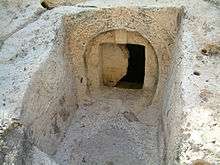
Walls, installations and pottery sherds from the Early Bronze Age IB and the Middle Bronze Age IIB, Iron, Hellenistic and Roman periods have been excavated at Shefa-'Amr.[5]
Settlement has existed there without interruption since the Roman period, when it was one of the cities mentioned in the Talmud as containing the seat of the Jewish Sanhedrin.[6] Decorated burial caves were documented by the Survey of Western Palestine in the late nineteenth century. They found the caves to be Christian tombs from the Byzantine era, dating to the 5th and 6th century CE. Greek inscriptions were also found.[4]
Archaeological excavations of a cave and quarries revealed that they were used in the Roman and Byzantine eras.[7] Shefa-'Amr contains Byzantine remains, including of a church and tombs.[8]
A salvage dig was conducted in the southern quarter of the old city exposing remains from five phases in the Late Byzantine and early Umayyad periods. Finds include a tabun, a pavement of small fieldstones, a mosaic pavement that was probably part of a wine press treading floor, a small square wine press, handmade kraters, an imported Cypriot bowl and an open cooking pot. Also discovered were glass and pottery vessels.[9]
Middle Ages
Under the Crusaders the place was known as "Safran", "Sapharanum", "Castrum Zafetanum", "Saphar castrum" or "Cafram".[10] The Crusader built a fortress, used by the Knights Templar, in the village. At the foot of the castle was a fortified settlement with a church, inhabited either by local Christians or Crusaders.[11] The village, then called "Shafar 'Am", was used by Saladin between 1190–91 and 1193-94 as a military base for attacks on Acre.[12]
By 1229, the place was back in Crusader hands, and it was confirmed as such by Sultan Baybars in the peace treaty of 1271, and by Sultan Qalawun in 1283.[13] Italian monk Riccoldo da Monte di Croce visited the village in 1287–88, and noted that it had Christian inhabitants.[14] It apparently was under Mamluk control by 1291,[15][16] as it was mentioned in that year when sultan al-Ashraf Khalil allocated the town's income to a charitable organization in Cairo.[17]
Ottoman era
During early Ottoman rule in the Galilee, in 1564, the revenues of the village of Shefa-'Amr were designated for the new waqf of Hasseki Sultan Imaret in Jerusalem, established by Hasseki Hurrem Sultan (Roxelana), the wife of Suleiman the Magnificent.[18] In the early decades of that century there had been a very small number of Jews mentioned, but none at the end of the century.[19]
A firman dated to 1573 mentioned that Shefa-'Amr was among a group of villages in the nahiya (sub district) of Akka which had rebelled against the Ottoman administration. By 1577, the village had accumulated an arsenal of 200 muskets.[20] In the 1596 tax records, Shefa-'Amr was part of the nahiya of Akka, part of Safad Sanjak, with a population of 83 households (khana), and eight bachelors, all Muslims. The total revenue were of 13,600 akçe, most of which were given as fixed amount.[21] The taxable produce also comprised occasional revenues, goats and beehives, and the inhabitants paid for the use or ownership of an olive oil press.[22][23]
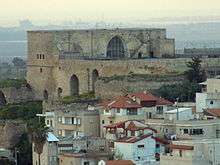
It was not until the 18th century that the village rose to prominence. At the beginning of the century the village was under control of Shaykh Ali Zaydani, the uncle of Zahir al-Umar and leading shaykh of lower Galilee. It is also known that there was a castle in the village at least as early as 1740. After Zahir al-Umar's rise to power in the 1740s, Ali Zaydani was replaced with his nephew, Uthman; a son of Zahir. After Zahir's death in 1775, Jazzar Pasha allowed Uthman to continue as the governor of Shefa-'Amr in return for a promise of loyalty and advance payment of taxes. Jazzar Pasha allowed the fortress to remain intact despite orders from Constantinople that it should be destroyed.[24] Several years later Uthman was removed and replaced with Ibrahim Abu Qalush, an appointee of Jazzar Pasha.[25]
During this period Shefa-'Amr was a regional centre of some importance due to its location in the heart of the cotton-growing area and its natural and man-made defenses. The significance of cotton to the growth of Shefa-'Amr was fundamental. Tax returns for the village attest to the large returns expected of this crop.[26] A definite indication of a Jewish presence in Shefa-'Amr was in the 18th century.[19] A map by Pierre Jacotin from Napoleon's invasion of 1799 showed the place, named as Chafa Amr.[27]
James Finn reported wrote in 1877 that "The majority of the inhabitants are Druses. There are a few Moslems and a few Christians; but [in 1850] there were thirty Jewish families living as agriculturists, cultivating grain and olives on their own landed property, most of it family inheritance; some of these people were of Algerine descent. They had their own synagogue and legally qualified butcher, and their numbers had formerly been more considerable." However, "they afterwards dwindled to two families, the rest removing to [Haifa] as that port rose in prosperity."[28] Conder and Kitchener, who visited in 1875, was told that the community consisted of "2,500 souls—1,200 being Moslems, the rest Druses, Greeks, and Latins."[29] The town's Druze community dwindled considerably in the 1880s as its members migrated east to the Hauran plain to avoid conscription by the Ottoman authorities.[30]
A population list from about 1887 showed that Shefa-'Amr had about 2,750 inhabitants; 795 Muslims, 95 Greek Catholics, 1,100 Catholic, 140 Latins, 175 Maronites/Protestants, 30 Jews and 440 Druze.[31]
British rule
At the time of the 1922 census of Palestine, Shefa-'Amr had a population of 2,288 inhabitants, consisting of 1,263 Christians, 623 Muslims, and 402 Druze.[32] Of the Christians, 1,054 were Melkites, 94 Anglicans, 70 Roman Catholics, 42 Greek Orthodox and three Maronite.[33] By the 1931 census, Shefa-'Amr had 629 occupied houses and a population of 1,321 Christians, 1,006 Muslims, 496 Druz, and one Jew. A further 1,197 Muslims in 234 occupied houses was recorded for "Shafa 'Amr Suburbs".[34]
Statistics compiled by the Mandatory government in the 1945 statistics showed an urban population of 1,560 Christians, 1,380 Muslims, 10 Jews and 690 "others" (presumably Druze) and a rural population of 3,560 Muslims.[35][36][37]
State of Israel
In 1948 Shefa-'Amr was captured by the Israeli Army during the first phase of Operation Dekel, between 8–14 July. The Druze population actively cooperated with the IDF. The Muslim quarter was heavily shelled and thousands of inhabitants fled to Saffuriyeh. Following the fall of Nazareth some of the refugees were allowed to return to their homes.[38] The population was placed under strict Martial Law. In November 1949 a group of notables from Shefa-'Amr gave the IDF a list of over 300 illegal residents in the town.[39] The military rule lasted until 1966.
On 16 May 2004, Whehebe Moheen, a man in his sixties, murdered Manal Najeeb Abu Raed, his widowed daughter in law, wife of his son, and mother of his two grand daughters.[40] The late Manal lost her husband to cancer two years earlier, and was living in the couple's home, in the Druze village of Daliat El Carmel, near Haifa. Following this event, a conflict have started between the family of the murdered and the murderer family, The final reconciliation took place on 27 February 2009, when about 300 family members, dignitaries and residents of the mixed city of Shefa-'Amr and the predominantly Druze city of Daliyat al-Carmel participated in the reconciliation ritual.[40] They gathered, along with Christian and Muslim dignitaries, including mayors of the two towns involved, Parliament members (Druze and Muslim), the religious leader of Israel's Druze community, and a sizable contingent of Druze religious leaders from many Druze villages in the north of Israel.[40] Following the speeches, the dignitaries signed the sulha (reconciliation) agreement, and after the document was declared officially endorsed, the killer's family handed the leader of the sulha committee, Sheikh Muafak Tarif, a bag containing the blood money (diya) compensation, and Tarif handed the bag to cousins of the murdered woman.[40] The bag contained 200,000 NIS (about $50,000). This is about half what a “normal” conciliation payment would be, but the killer's family refused to bring more money, claiming that they have no resources, and cannot run themselves bankrupt because of a “crazy” uncle.[40]
On 4 August 2005, an AWOL Israeli Defense Force soldier, Eden Natan-Zada, opened fire while aboard a bus in the city, killing four Arab residents and wounding twenty-two others. After the shooting, Natan-Zada was overcome by nearby crowds, lynched and beaten with rocks. According to witnesses, the bus driver was surprised to see a kippah-wearing Jewish soldier making his way to Shefa-'Amr via public bus, so inquired of Natan-Zada whether he was certain he wanted to take his current route. The four fatalities were Hazar and Dina Turki, two sisters in their early twenties, and two men, Michel Bahouth (the bus driver) and Nader Hayek. In the days following the attack, 40,000 people attended mass funeral services for the victims. The sisters were buried in an Islamic cemetery and the men were buried in the Christian Catholic cemetery. The wounded were taken to Rambam Hospital in Haifa. The Shefa-'Amr municipality established a monument to commemorate the victims.[41]
Geography
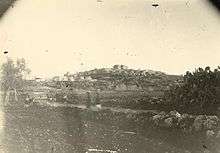
Shefa-'Amr is an ancient city located in the North District of Israel at the entrance to Galilee. It is located 13 kilometres (8.1 mi) from the Mediterranean Sea and 20 kilometres (12 mi) from each of three cities, Haifa, Acre and Nazareth, where many of the inhabitants are employed. The city is located on seven hills, which gives it the name "Little Rome". The elevation of the city and its strategic location as the connection between the valleys and mountains of Galilee made it more than once the center of its district, especially in the period of Uthman, the son of Zahir al-Umar, who built a castle in it, and towers around it. The bay of Haifa with the sea stretching between Haifa and Acre and the high mountains of Galilee and the valleys surrounding the city could be seen from high points in the city.
Politics and local government
Ibraheem Nimr Hussein, a former mayor of Shefa-'Amr, was chairman of the Committee of Arab Mayors in Israel (later the Arab Follow-Up Committee) from its inception in 1975.
In 1981 a NGO to promote health care in the Arab community was set up in Shefa-'Amr. It called itself The Galilee Society - the Arab National Society for Health Research and Services.[42]
In 1982, following the Israeli invasion of Lebanon, Mayor Ibrahim Nimr Husayn formed the "Supreme Follow-Up Committee" based on a committee that had been formed following Land Day. It consisted of 11 heads of local councils as well as Arab Members of Knesset. By the 1990s the committee, meeting in Nazareth, had expanded and become a mini-parliament representing Palestinians in the Galilee.[43]
According to Ynetnews, in January 2008, Mayor Ursan Yassin met with officials of the Israeli state committee on the celebrations for the 60th anniversary of independence, and announced that Shefa-'Amr intended to take part in the celebrations.[44]
In 2011, 7,000 Christians, Druze and Muslims held a solidarity march in support of Christians in Iraq and Egypt who are suffering from religious persecution.[45]
Demographics
| Arab citizens of Israel |
|---|
| Politics |
|
| Religion |
| Culture |
| Major population centers |
| Personalities |
| See also |
|
In 1951, the population was 4450, of whom about 10% were internally displaced persons from other villages.[46] During the early 1950s, about 25,000 dunams of the land of Shefa Amr was expropriated by the following method: the land was declared a closed military area, then after enough time had passed for it to have become legally "uncultivated", the Minister of Agriculture used his powers to "ensure that it was cultivated" by giving it to neighboring Jewish majority communities. Some of the land was owned by Jews.[47] Another 7,579 dunams was expropriated in 1953–4.[48] The total land holdings of the village fell from 58,725 dunams in 1945 to 10,371 dunams in 1962.[48]
Shfar'am's diverse population drawn from several different communities gives the city a relatively cosmopolitan and multi-cultural ambiance.
According to CBS, in 2012 the religious and ethnic makeup of the city was mostly Israeli Arabs (consisting of 60.5% Muslim, 25.2% Christian, and 14.3% Druze). According to CBS, in 2012 there were 38,300 registered citizens in the city. The age distribution of the city consisted of 40.4% of the population 19 years of age or younger, 14.9% between 20 and 29, 21.1% between 30 and 44, 17.8% from 45 to 64, and 5.7% 65 years of age or older.
Population in Shefa-'Amr over the years:

Economy
According to the CBS, in 2012 there were 12,494 salaried and 1062 self-employed workers in the city . The mean monthly wage in 2012 for a salaried worker in the city was ILS 5,412. Salaried males had a mean monthly wage of ILS 6,312 versus ILS 3,904 for females. The mean income for the self-employed was ILS 7,381. 235 people received unemployment benefits and 3,971 received an income guarantee.
Education and culture
In 2012, there were 24 schools serving a student population of 9,459: 15 elementary schools with 5,360 students and 13 high schools with 4,099 students. In 2012, 53.7% of twelfth grade students earned a matriculation certificate. In the eastern part of the city, Mifal HaPayis built a public computer center, a public library, a large events hall and more.
Shefa-'Amr is also home to Tamrat El Zeitoun, an elementary school (about 150 students) notable for serving Muslim, Christian, and Druze together and being the only Arabic language Waldorf school. In collaboration with Waldorf educators at Harduf the school developed a language curriculum accommodating the differences between written and spoken Arabic. The school celebrates the festivals from all three religions.[49][50][51]
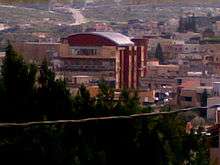
The Beit Almusica conservatory was founded in 1999 by musician Aamer Nakhleh in the center of Shefa-'Amr. It offers a year-round programs of music studies in various instruments, and holds music performances and concerts.[52] Every year Shefa-'Amr holds a music festival known as the "Fort Festival." Arab children from all over the country compete in singing classic Arabic songs and one is chosen as "Voice of the Year." The Ba'ath choir, established by Raheeb Haddad, performs all over the country and participates in many international events. Singer Reem Talhami performs all over the Arab world. Celebrated oud player and violinist Tayseer Elias, on the Beit Almusica staff, is a composer, conductor and musicologist who also lectures at Bar-Ilan University.[53] Butrus Lusia, a painter, specializes in icons for Christian churches.

The first plays in Shefa-'Amr were performed in the 1950s by the Christian scouts. Since the 1970s, many theaters have opened. among them the sons of Shefa-A'mr theater, Athar theater, house of the youth theater, Alghurbal Al Shefa-'Amry theater and Al Ufok theater. The largest theater in the city is the Ghurbal Establishment which is a national Arab theater. Sa'eed Salame, an actor, comedian and pantomimist, established a 3-day international pantomime festival that is held annually.
Shefa-'Amr is known for its mastic-based ice cream, bozet Shefa-'Amr.The Nakhleh Coffee Company is the leading coffee producer in Israel's Arab community. New restaurant-cafes have been opened in parts of the old city; those places are becoming the main cafes the youth of Shefa-Amr choose to spend their free time and special occasions in. The Awt Cafe started holding musical nights where local singers and instruments players including oud and others perform for the audience. Such events have sparked a popular nightlife for locals.
Landmarks and religious sites
- A fort was built in 1760 by Zahir al-Umar, governor of the region, to secure the entrance to Galilee. The fort was built on remains of a Crusader fort called "Le Seffram". The ground floor of the fort stabled the horses, the first floor above ground was for Zahir's residential quarters. Zahir's fort is considered the biggest remaining of the forts in the Galilee. After the establishment of the state, the fort was used as a police station. After a new station was built in the "Fawwar" neighbourhood, it was renovated and converted to a youth center club, which has since closed down.[54]
- "The Tower" or "al Burj" is an old Crusader fort located in the southern part of the city.

- The old market of Shefa-'Amr was once the bustling heart of the city. Now all that remains is one coffee shop where elderly men gather every day to play backgammon and drink coffee. According to the mayor of Shefa-Amr, Nahed Khazem, the government has provided a budget for improving and reviving the old market and developing the area around the fort as a tourist attraction.
- The Shfaram Ancient Synagogue is an old synagogue on the site of an even older structure. It is recorded as being active in 1845. A Muslim resident of the town holds the keys.[55] The synagogue was renovated in 2006. The tomb of Rabbi Judah ben Baba, a well-known rabbi from the 2nd century who was captured and executed by the Romans, is still standing and many Jewish believers come to visit it.
- Byzantine period tombs are located in the middle of the city. They were the graves of the 5th and 6th-century Christian community. The tomb entrances are decorated with sculptures of lions and Greek inscriptions which make mention of Jesus.[4]
- In the center of the city, where the Sisters of Nazareth convent now stands, was a 4th-century church, St. Jacob's. This church is mentioned in the notes of Christian church historians, although the original church has been replaced by the monastery. Some marble columns remain, similar to those used to build the earliest churches.
- St. Peter & St. Paul Church is located in one of the town's peaks near the fort, it has a high bell tower and a large purple dome. The church was built by Otman, who made a promise to build it if his fort was finished successfully. The walls of the church began to weaken and in 1904 the entire church building was reinforced and renovated. This is the main church of the local Greek Catholic community.
- The Mosque of Ali Ibn Abi Talib (Old Mosque) was constructed near the castle in the days of Sulayman Pasha
Notable residents
- Karimeh Abbud
- Ghassan Alian, first non-Jewish commander of the Golani Brigade
- Mansour F. Armaly
- Zahi Armeli (born 1957), former footballer
- Mohammad Barakeh
- Emile Habibi (1922–96), Christian Israeli-Palestinian writer and communist politician
See also
- Arab localities in Israel
- People from Shefa-'Amr
References
- "Population in the Localities 2019" (XLS). Israel Central Bureau of Statistics. Retrieved 16 August 2020.
- "General" (PDF). Israel Central Bureau of Statistics.
- Palmer, 1881, p.116
- Conder and Kitchener, 1881, SWP I, 339 -343
- Feig, 2014, ‘En Shefar‘am, Final report
- Talmud Bavli Rosh Hashana. p. 31b.
- Atrash, 2016, Shefar‘am, Highway 79
- Conder and Kitchener, 1881, SWP I, p. 343; Guérin, 1880, p 414, TIR, 230. All cited in Petersen, 2001, p. 276
- Abu Raya, 2010, Shefar‘am Final Report
- Pringle, 1997, p. 115
- Ellenblum, 2003, p. 143
- Abu Shama RHC (or.), IV, p. 487. Yaqut, p. 304, Both cited in Petersen, 2001, p. 277
- Barag, 1979, p. 207, No. 63.
- Ellenblum, 2003, p. 144
- Ibn al-Furat, Cited in Petersen, 2001, p. 277
- Pringle, 1998, pp. 301-4
- Barag, 1979, p. 203
- Singer, 2002, p. 126
- Alex Carmel, Peter Schäfer & Yossi Ben-Artzi (1990). The Jewish Settlement in Palestine, 634–1881. Beihefte zum Tübinger Atlas des Vorderen Orients : Reihe B, Geisteswissenschaften; Nr. 88. Wiesbaden: Reichert. pp. 94, 144.
- Heyd, 1960, pp. 84-85, no. 2. Cited in Petersen, 2001, p. 277
- Hütteroth and Abdulfattah, 1977, p. 192
- Hütteroth and Abdulfattah, 1977, p. 192. Also quoted in Petersen, 2001, p. 277
- Note that Rhode, 1979, p. 6 writes that the register that Hütteroth and Abdulfattah studied was not from 1595/6, but from 1548/9.
- Cohen, 1973, p. 106. Cited in Petersen, 2001, p. 277
- Cohen, 1973, p. 25. Cited in Petersen, 2001, p. 277
- Cohen, 1973, p. 128. Cited in Petersen, 2001, p. 277
- Karmon, 1960, p. 162 (PDF)
- Finn, 1877, p. 243
- Conder and Kitchener, 1881, SWP I, p. 272
- Firro, 1992, p. 168.
- Schumacher, 1888, p. 175
- Barron, 1923, Table XI, Sub-district of Haifa, p.33
- Barron, 1923, Table XVI, p.49
- Mills, 1932, p. 96 (PDF)
- Department of Statistics, 1945, p. 15
- Government of Palestine, Department of Statistics. Village Statistics, April, 1945. Quoted in Hadawi, 1970, p. 49
- Sami Hadawi (1957). Land Ownership in Palestine. New York: Palestine Arab Refugee Office. p. 44.
- Morris, 1987, pp.199, 200, 202
- Morris, 1993, p. 146
- http://www.sulha.org/2009/03/04/sulha-in-shefaram/
- Sorek, Tamir (2015). Palestinian Commemoration in Israel: Calendars, Monuments, and Martyrs. Stanford, CA: Stanford University Press. ISBN 9780804795203., p. 109
- Pappe, Ilan (2011) The Forgotten Palestinians. A History of the Palestinians in Israel. Yale. ISBN 978-0-300-13441-4. p.198
- Pappe. p.146
- "Arab town plans big celebration for Israel's Independence Day". ynet.
- "Shfaram: 7,000 march in solidarity with Christians". The Jerusalem Post - JPost.com.
- Kamen (1987). "After the Catastrophe I: The Arabs in Israel, 1948-51". Middle Eastern Studies. 23 (4): 453–495. doi:10.1080/00263208708700721.
- Jiryis, S. (1973). "The Legal Structure for the Expropriation and Absorption of Arab Lands in Israel". Journal of Palestine Studies. 2 (4): 82–104. doi:10.1525/jps.1973.2.4.00p0099c.
- Jiryis, S. (1976). "The Land Question in Israel". MERIP Reports. 47 (47): 5––20+24–26. doi:10.2307/3011382. JSTOR 3011382.
- "Waldorf Worldwide: Learning for peace". Freunde der Erziehungskunst Rudolf Steiners. Retrieved March 22, 2013.
- "Shalaam Shalom: Teaching children in the Middle East pathways to peace". Waldorf Today. Retrieved March 22, 2013.
- Goldshmidt, Gilad (December 2011). "Interkultureller Brückenschlag". Bund der Freien Waldorfschulen e.V. Retrieved March 6, 2014.
- "بيت الموسيقى - شفاعمرو". beit-almusica.org.
- Tayseer Elias in the Hebrew Wikipedia. Retrieved 21 December 2016
- Syon and Hillmann, 2006, Shefar‘am, Final report
- שי ניר (August 31, 2018). "אופטימיות ופחד (Optimism and Fear)". Davar Rishon. Retrieved 2019-07-20.
Bibliography
- Abu Raya, Rafeh (2010-08-01). "'En Shefar'am Final Report" (122). Hadashot Arkheologiyot – Excavations and Surveys in Israel. Cite journal requires
|journal=(help) - Abu Shama (d.1268) (1969): Livre des deux jardins ("The Book of Two Gardens"). Recueil des Historiens des Croisades, Cited in Petersen (2001).
- Atrash, Walid (2016-07-18). "'En Shefar'am Highway 79" (128). Hadashot Arkheologiyot – Excavations and Surveys in Israel. Cite journal requires
|journal=(help) - Barag, Dan (1979). "A new source concerning the ultimate borders of the Latin Kingdom of Jerusalem". Israel Exploration Journal. 29: 197–217.
- Barron, J.B., ed. (1923). Palestine: Report and General Abstracts of the Census of 1922. Government of Palestine.
- Cohen, Amnon (1973). Palestine in the Eighteenth Century: Patterns of Government and Administration. Jerusalem: Magnes Press, Hebrew University. ISBN 1-59045-955-5. Cited in Petersen, (2001)
- Conder, C.R.; Kitchener, H.H. (1881). The Survey of Western Palestine: Memoirs of the Topography, Orography, Hydrography, and Archaeology. 1. London: Committee of the Palestine Exploration Fund. p. 271-3,
- Department of Statistics (1945). Village Statistics, April, 1945. Government of Palestine.
- Ellenblum, Ronnie (2003). Frankish Rural Settlement in the Latin Kingdom of Jerusalem. Cambridge University Press. ISBN 9780521521871.
- Feig, Nurit (2014-08-28). "'En Shefar'am Final Report" (126). Hadashot Arkheologiyot – Excavations and Surveys in Israel. Cite journal requires
|journal=(help) - Finn, J. (1877). Byeways in Palestine. London: James Nisbet.
- Firro, Kais (1992). A History of the Druzes. 1. BRILL. ISBN 9004094377.
- Guérin, V. (1880). Description Géographique Historique et Archéologique de la Palestine (in French). 3: Galilee, pt. 1. Paris: L'Imprimerie Nationale.
- Hadawi, S. (1970). Village Statistics of 1945: A Classification of Land and Area ownership in Palestine. Palestine Liberation Organization Research Center.
- Heyd, Uriel (1960): Ottoman Documents on Palestine, 1552-1615, Oxford University Press, Oxford. Cited in Petersen (2001)
- Herzog, C. and S. Gazit, The Arab-Israeli Wars, Vintage books, 2005.
- Hütteroth, Wolf-Dieter; Abdulfattah, Kamal (1977). Historical Geography of Palestine, Transjordan and Southern Syria in the Late 16th Century. Erlanger Geographische Arbeiten, Sonderband 5. Erlangen, Germany: Vorstand der Fränkischen Geographischen Gesellschaft. ISBN 3-920405-41-2.
- Karmon, Y. (1960). "An Analysis of Jacotin's Map of Palestine" (PDF). Israel Exploration Journal. 10 (3, 4): 155–173, 244–253.
- Mariti, G. (1792). Travels Through Cyprus, Syria, and Palestine; with a General History of the Levant. 1. Dublin: P. Byrne. (pp. 366-367)
- Mills, E., ed. (1932). Census of Palestine 1931. Population of Villages, Towns and Administrative Areas. Jerusalem: Government of Palestine.
- Morris, B. (1987). The Birth of the Palestinian refugee problem, 1947-1949. Cambridge University Press. ISBN 0-521-33028-9.
- Morris, B. (1993). Israel's Border Wars, 1949 - 1956. Arab Infiltration, Israeli Retaliation, and the Countdown to the Suez War. Oxford University Press. ISBN 0-19-827850-0.
- Vilnai, Z., "Shefa-'Amr, Between the past and the present", Jerusalem 1962.
- Palmer, E.H. (1881). The Survey of Western Palestine: Arabic and English Name Lists Collected During the Survey by Lieutenants Conder and Kitchener, R. E. Transliterated and Explained by E.H. Palmer. Committee of the Palestine Exploration Fund.
- Petersen, Andrew (2001). A Gazetteer of Buildings in Muslim Palestine (British Academy Monographs in Archaeology). 1. Oxford University Press. ISBN 978-0-19-727011-0.
- Pringle, Denys (1997). Secular buildings in the Crusader Kingdom of Jerusalem: an archaeological Gazetter. Cambridge University Press. ISBN 0-521-46010-7.
- Pringle, Denys (1998). The Churches of the Crusader Kingdom of Jerusalem: L-Z (excluding Tyre). 2. Cambridge University Press. ISBN 0-521-39037-0.
- Rhode, H. (1979). Administration and Population of the Sancak of Safed in the Sixteenth Century (PhD). Columbia University.
- Rogers, Mary Eliza, (1865): Domestic Life in Palestine (Also cited in Petersen, 2001)
- Schumacher, G. (1888). "Population list of the Liwa of Akka". Quarterly Statement - Palestine Exploration Fund. 20: 169–191.
- Singer, A. (2002). Constructing Ottoman Beneficence: An Imperial Soup Kitchen in Jerusalem. Albany: State University of New York Press. ISBN 0-7914-5352-9.
- Sorek, Tamir (2015). Palestinian Commemoration in Israel: Calendars, Monuments, and Martyrs. Stanford, CA: Stanford University Press. ISBN 9780804795203.
- Syon, Danny; Hillmann, Avner (2006-04-24). "'En Shefar'am Final Report" (118). Hadashot Arkheologiyot – Excavations and Surveys in Israel. Cite journal requires
|journal=(help) - Tsafrir, Y.; Leah Di Segni; Judith Green (1994). (TIR): Tabula Imperii Romani: Judaea, Palaestina. Jerusalem: Israel Academy of Sciences and Humanities. ISBN 965-208-107-8.
External links
- Official website (in Arabic)
- Welcome To Shafa Amr
- Survey of Western Palestine, Map 5: IAA, Wikimedia commons
